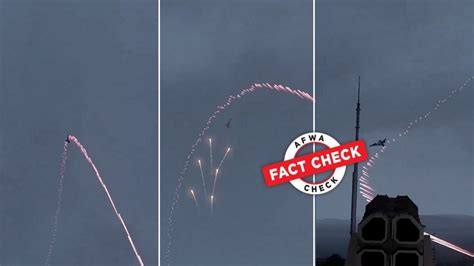
A widely circulated image purportedly showing an Israeli F-35 fighter jet shot down by Iran is false and has been debunked by fact-checkers. The image, which gained traction on social media platforms, is not related to any recent events and is not authentic, according to analysis of the image and available reports.
Claims that Iran downed an Israeli F-35 stealth fighter using an air defense system, accompanied by the viral image, have been circulating online, particularly in the wake of heightened tensions in the Middle East. However, visual inspection and reverse image searches reveal that the image is not new and has been available online for a considerable period. There is no credible evidence to support the claim that the image depicts a downed Israeli F-35, nor are there any verifiable reports from reliable news sources confirming such an incident.
The spread of misinformation surrounding geopolitical events, especially in conflict zones, can have serious consequences. Such false claims can inflame tensions, incite violence, and undermine trust in reliable news sources. It is crucial to critically assess information shared online, especially images and videos, and to rely on reputable news organizations for accurate reporting.
The specific image in question has been circulating with varying claims, often related to military conflicts or exercises. However, the image’s origin and context remain unclear. Fact-checking organizations have consistently flagged the image as lacking verifiable information and being used to spread disinformation. The visual characteristics of the image, such as the type of aircraft damage and the surrounding environment, do not align with known details of F-35 crashes or incidents.
“There is no evidence to support the claim that the image depicts a downed Israeli F-35,” fact-checking sources confirm. These sources have examined the image and found no indication that it is related to a real event involving the downing of an Israeli aircraft.
The emergence of this false claim underscores the importance of media literacy and critical thinking in the digital age. Individuals should be wary of sensational claims and unverified images circulating online, especially those related to sensitive geopolitical topics. It is essential to consult multiple credible sources and to rely on fact-checking organizations to verify the accuracy of information before sharing it.
The use of social media and online platforms for the dissemination of misinformation poses a significant challenge to maintaining an informed and accurate understanding of world events. The speed and scale at which false claims can spread online make it difficult to counter their impact. Efforts to combat misinformation require a multi-faceted approach, including media literacy education, fact-checking initiatives, and cooperation between social media platforms and news organizations.
The claim that Iran shot down an Israeli F-35 is not supported by credible evidence. The image circulating online is not authentic and has been debunked by fact-checkers. It is crucial to rely on reputable news sources for accurate reporting and to critically assess information shared online, especially in the context of geopolitical tensions.
The origins of this particular instance of misinformation are difficult to definitively pinpoint, but it aligns with broader trends in online disinformation campaigns. Often, these campaigns seek to exploit existing tensions and divisions, using fabricated or misleading content to incite emotional reactions and sow discord. The proliferation of such campaigns underscores the need for vigilance and critical thinking when consuming information online.
In the absence of official reports or credible sources corroborating the claim, it is reasonable to dismiss it as unfounded. Governments and military organizations typically acknowledge significant incidents involving military aircraft, especially those involving advanced technology like the F-35. The lack of any such acknowledgement further undermines the credibility of the claim.
Moreover, the geopolitical context in which the claim emerged is important to consider. Tensions between Iran and Israel have been elevated for years, with frequent exchanges of accusations and threats. In this environment, false claims and disinformation can easily spread, exacerbating existing tensions and potentially leading to miscalculations or escalations.
The F-35 fighter jet is a highly advanced and expensive military asset, and any incident involving its loss or damage would be a significant event. Such an event would likely trigger a thorough investigation and would be widely reported by international news media. The absence of such reporting further undermines the credibility of the claim that an Israeli F-35 was shot down by Iran.
Furthermore, the technology incorporated in the F-35, including stealth capabilities and advanced electronic warfare systems, is designed to minimize its vulnerability to enemy air defenses. While the F-35 is not invulnerable, it is considered one of the most survivable fighter jets in the world. The claim that it was easily shot down by Iran, without any supporting evidence, is therefore highly improbable.
The fact that the image has been circulating online for some time, with different claims attached to it, further suggests that it is not related to any recent events involving Iran and Israel. Disinformation campaigns often repurpose old images and videos, attaching them to new narratives in order to exploit current events and manipulate public opinion.
In conclusion, the claim that Iran shot down an Israeli F-35 and that the viral image proves it is false and misleading. There is no credible evidence to support this claim, and the image has been debunked by fact-checking organizations. It is crucial to rely on reputable news sources for accurate reporting and to critically assess information shared online, especially in the context of geopolitical tensions. The spread of misinformation can have serious consequences, and it is essential to be vigilant and discerning when consuming information online.
The debunking of this false claim highlights the importance of fact-checking as a crucial tool in combating disinformation. Fact-checking organizations play a vital role in verifying the accuracy of information and exposing false claims, helping to ensure that the public has access to accurate and reliable news. Their work is essential for maintaining an informed and democratic society.
The implications of spreading false claims extend beyond the immediate context of the specific event. Disinformation can erode trust in institutions, undermine social cohesion, and even incite violence. It is therefore crucial to address the underlying causes of misinformation and to promote media literacy and critical thinking skills.
One of the challenges in combating misinformation is the speed and scale at which false claims can spread online. Social media platforms have become powerful tools for disseminating information, but they also provide a fertile ground for the spread of disinformation. Addressing this challenge requires a coordinated effort involving social media platforms, news organizations, fact-checking organizations, and individuals.
Social media platforms have a responsibility to take steps to prevent the spread of disinformation on their platforms. This includes implementing algorithms to detect and flag false claims, partnering with fact-checking organizations to verify the accuracy of information, and providing users with tools to report and identify disinformation.
News organizations also have a crucial role to play in combating misinformation. This includes adhering to high journalistic standards, verifying the accuracy of information before publishing it, and providing clear and transparent sourcing. News organizations should also actively debunk false claims and provide their audiences with the tools and knowledge to identify disinformation.
Fact-checking organizations play a vital role in verifying the accuracy of information and exposing false claims. These organizations use a variety of methods to fact-check information, including consulting with experts, examining primary sources, and conducting reverse image searches. Their work is essential for maintaining an informed and democratic society.
Individuals also have a responsibility to combat misinformation. This includes being critical of the information they consume online, verifying the accuracy of information before sharing it, and reporting false claims to social media platforms. Individuals should also educate themselves about media literacy and critical thinking skills.
The spread of misinformation is a complex and multifaceted problem that requires a coordinated and sustained effort to address. By working together, social media platforms, news organizations, fact-checking organizations, and individuals can help to combat misinformation and ensure that the public has access to accurate and reliable information.
The proliferation of generative AI also presents new challenges for combating misinformation. AI-generated images and videos can be highly realistic and difficult to distinguish from authentic content. This makes it easier for malicious actors to create and disseminate disinformation.
To address this challenge, it is important to develop new tools and techniques for detecting AI-generated content. This includes using AI itself to identify patterns and anomalies in images and videos that are indicative of AI generation. It also includes developing forensic techniques for analyzing AI-generated content and identifying its source.
In addition, it is important to educate the public about the potential for AI-generated disinformation. This includes teaching people how to identify AI-generated content and how to critically evaluate the information they consume online.
The claim regarding Iran shooting down the Israeli F-35, and its debunking, is a crucial case study in understanding the dynamics of online information warfare. It showcases how quickly misinformation can spread, the potential damage it can cause, and the importance of robust fact-checking mechanisms. As the geopolitical landscape continues to evolve, so too will the tactics used to spread disinformation. Therefore, continuous vigilance, adaptation, and collaboration are key to maintaining an informed and resilient public sphere.
The F-35, being a symbol of advanced military technology, is often a target for propaganda and misinformation campaigns. Its capabilities are frequently exaggerated or misrepresented to either bolster or undermine its perceived effectiveness. This specific incident involving the false claim of it being shot down is just one example of how such high-profile military assets become focal points in information warfare. Understanding this dynamic is essential for anyone analyzing geopolitical conflicts and military capabilities.
The role of state-sponsored actors in spreading disinformation is another critical aspect to consider. While it’s not always possible to definitively attribute specific disinformation campaigns to particular actors, the sophistication and scale of some operations suggest a level of coordination and resources that are often associated with state-sponsored activities. Identifying and countering these state-sponsored campaigns is a major challenge for governments and security agencies around the world.
The economic incentives behind the spread of misinformation also need to be addressed. Many websites and social media accounts profit from the spread of sensational or controversial content, regardless of its accuracy. This creates a perverse incentive to prioritize engagement over truth, which can lead to the amplification of false claims and disinformation. Addressing this economic incentive requires a multifaceted approach, including regulation, public awareness campaigns, and the development of alternative business models for online media.
The increasing sophistication of disinformation tactics requires a corresponding increase in the sophistication of fact-checking and media literacy efforts. Traditional fact-checking methods, such as relying on expert sources and primary documents, are still essential, but they need to be supplemented by new techniques that can detect and analyze AI-generated content, identify coordinated disinformation campaigns, and track the spread of false claims across social media networks. Media literacy education also needs to be updated to reflect the changing information landscape, focusing on critical thinking skills, source evaluation, and the ability to identify common disinformation tactics.
In conclusion, the debunked claim about the Israeli F-35 is a reminder of the ongoing challenges posed by online disinformation. Combating this threat requires a coordinated effort involving governments, social media platforms, news organizations, fact-checking organizations, and individuals. By working together, we can help to create a more informed and resilient public sphere.
Frequently Asked Questions (FAQ)
Q1: What is the main claim being debunked in the news article?
A: The main claim being debunked is that Iran shot down an Israeli F-35 fighter jet, and that a widely circulated image proves this incident. The article clarifies that the image is not related to any recent events and is not authentic. Fact-checking organizations have found no credible evidence to support the claim.
Q2: Where did the false image originate, and how did it spread?
A: The article states that the image’s origin and context remain unclear, but it has been circulating online for a considerable time with varying claims. The image gained traction on social media platforms, particularly following heightened tensions in the Middle East. The speed and scale at which false claims spread online make it difficult to counter their impact.
Q3: What are the potential consequences of spreading misinformation, especially regarding geopolitical conflicts?
A: Spreading misinformation surrounding geopolitical events can have serious consequences, including inflaming tensions, inciting violence, undermining trust in reliable news sources, eroding trust in institutions, and undermining social cohesion. Such false claims can also lead to miscalculations or escalations in conflicts.
Q4: What are the main tools and strategies that individuals and organizations can use to combat misinformation?
A: The article emphasizes the importance of media literacy and critical thinking. Individuals should be wary of sensational claims and unverified images, consult multiple credible sources, and rely on fact-checking organizations. Social media platforms need to implement algorithms to detect and flag false claims and partner with fact-checking organizations. News organizations should adhere to high journalistic standards and actively debunk false claims.
Q5: What role do AI and state-sponsored actors play in the spread of misinformation, and how can these challenges be addressed?
A: Generative AI presents new challenges by creating highly realistic and difficult-to-detect fake content. The article suggests developing new tools for detecting AI-generated content and educating the public about AI-generated disinformation. State-sponsored actors can be involved in sophisticated disinformation campaigns, requiring governments and security agencies to identify and counter them. The economic incentives that profit from spreading misinformation also need to be addressed through regulations, public awareness, and alternative business models for online media.









